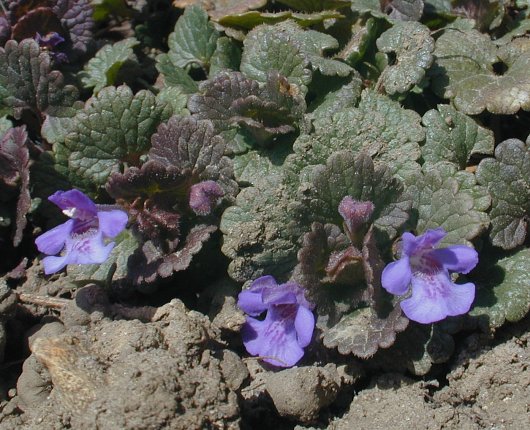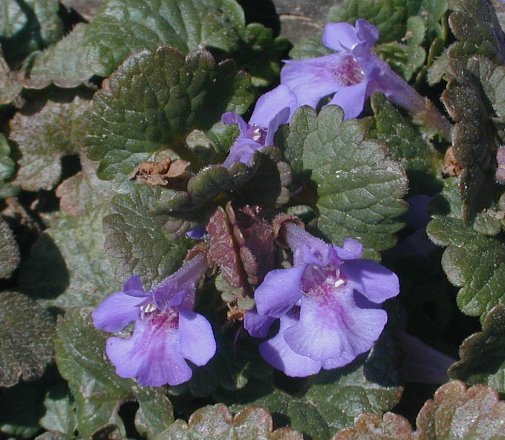Description: This herbaceous perennial plant is usually 1' or less, branching frequently and forming a low-growing mat of stems and leaves across the ground. The 4-angled stems are prostrate to slightly ascending, and often form rootlets near the axils of the leaves when they touch the ground. The opposite leaves are about 1" long and across. They are green to purplish green, orbicular, and crenate along the margins. There is a flat indentation where the long petiole joins the base of a leaf. The pubescent upper surface has conspicuous palmate venation. Clusters of 1-3 tubular flowers develop from the leaf axils. These flowers are bluish violet to reddish purple and about ½" in length. The corolla of each flower is narrow at the base, but flares outward like a trumpet into spreading lobes. There is a notched upper lobe, a notched lower lobe, and 2 smaller side lobes. The lower lobe is larger than the others and functions as a landing pad for visiting insects. It has darker violet lines that function as nectar guides. Within the throat of the corolla, there are fuzzy hairs. Each flower has a single pistil with a divided style, 2 long stamens, and 2 short stamens. The pubescent calyx is about 1/3 the length of the tubular corolla, with 15 veins running along its length and 5 teeth along its outer edge.

The blooming
period usually occurs from mid-spring to early summer for about 2
months, although some plants may bloom later in the year if they remain
in cool shade or a major disturbance prevents earlier bloom. Upon
maturity, each flower is replaced by 4 dark brown nutlets. Each nutlet
is ovoid, with 2 flat sides and an outer side that is rounded. The root
system is fibrous and shallow. This plant often forms dense colonies by
forming rootlets along the stems.
Cultivation:
The preference is partial sun, moist conditions, and fertile loamy soil
in an open situation where there is little ground cover. This species
can spread aggressively and is difficult to destroy without resorting
to herbicides. During hot summer weather, it has a tendency to become
dormant.
Range & Habitat:
The non-native Ground Ivy is occasional to locally common in most areas
of Illinois
(see Distribution
Map). It was introduced into North America from Europe.
Habitats include openings of floodplain
forests, semi-shaded areas along rivers, powerline clearances in
woodland areas, cemeteries, lawns and gardens, and miscellaneous waste
areas. This plant can withstand regular mowing, but flourishes better
without it. It prefers disturbed areas, but occasionally invades higher
quality natural areas. Sometimes homeowners tolerate its presence in
lawns because they like the flowers.

Faunal
Associations:
The nectar of the flowers attracts long-tongued bees primarily,
including honeybees, bumblebees, mason bees (Osmia spp.), a
cuckoo bee (Nomada
superba), a long-horned bee (Synhalonia speciosa),
an Anthophorine bee (Anthophora
abrupta), and small carpenter bees (Ceratina spp.).
Occasionally, the flowers attract green metallic bees (Augochlorella striata,
Augochloropsis
metallica), bee
flies (Bombylius spp.),
a Syrphid fly (Rhingia
nasica), Sulfur and White butterflies, and skippers
(Robertson, 1929). The caterpillars of a polyphagous moth, Xanthotype
urticaria (False Crocus Geometer), feed on the foliage of
Ground
Ivy, while the larvae of Liposthenes
glechomae (Ground Ivy Gall Wasp) form galls on the stems,
petioles, or leaves (Covell, 1984/2005; Felt, 1917). The foliage of
this plant is considered toxic to
domesticated livetock, especially horses. However, the European Wild
Boar, a species that has naturalized in the United States, reportedly
uses the leaves as a source of food (Waggy, 2009). The leaves are also
eaten by the Ruffed Grouse (Bennetts, 1900).
Photographic Location:
At the edge of a flower garden in Urbana, Illinois.
Comments:
Ground Ivy is an important source of nectar during the spring for bees.
Otherwise, its ecological value is rather low. The size and color of
the flowers are somewhat variable. This species resembles another
introduced member of the Mint family, Lamium amplexicaule
(Henbit), which is also an aggressive spreader. However, the opposite
leaves of Henbit are more widely spaced along its spreading stems and
they strongly clasp the stems, while the leaves of Ground Ivy have long
petioles. The flowers of Henbit occur in whorls from the axils of the
upper leaves, and they are more erect and pink than the flowers of
Ground Ivy. Other members of the Mint family usually have an erect
habit, while the stems of Ground Ivy often sprawl about and form loose
mats. Another common name for this species is Gill-over-the-Ground,
which is more often used in England.